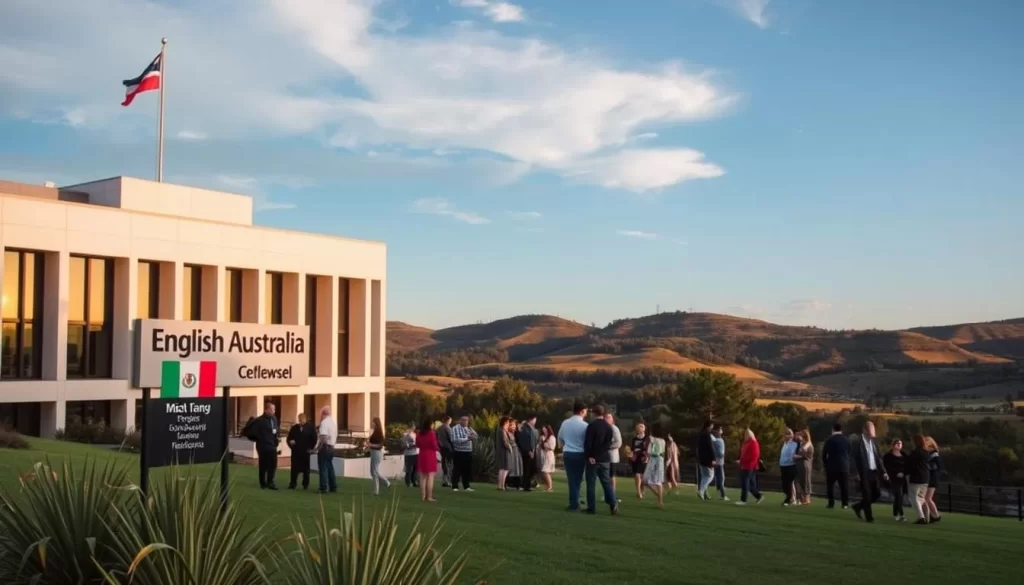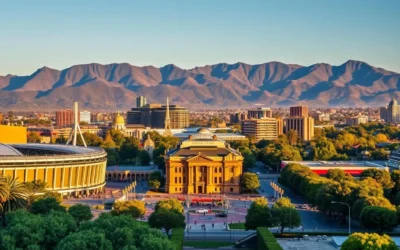South Australia is a vibrant state known for its rich cultural heritage and diverse population. At the heart of this diversity lies its unique linguistic landscape. Language plays a crucial role in shaping the identity of this region, reflecting its history and multicultural roots.
In 2021, 77.6% of residents in this state spoke only English at home, a slight decrease from previous years. This shift highlights the growing influence of other languages, such as Mandarin, Italian, and Greek, which are commonly spoken in households.
Understanding the linguistic diversity of this state offers valuable insights into its cultural fabric. Whether you’re exploring its history or engaging with its communities, language serves as a bridge to deeper connections.
Introduction to Linguistic Diversity in South Australia
The linguistic landscape of this region reflects a rich blend of cultures and histories. Over 300 languages are spoken here, showcasing a vibrant tapestry of voices. This diversity is shaped by both locals and those born overseas, creating a unique language environment.
In recent years, the number of people speaking languages other than English at home has grown. About 20% of the population uses a second language daily. This trend highlights the region’s multicultural character and the influence of immigration.

The government has played a key role in fostering this diversity. Policies supporting multilingual education and community programs have helped preserve and promote various languages. For example, over 60 community language schools operate here, serving thousands of students.
Historical immigration has also left a lasting impact. Between 2000 and 2014, around 200,000 humanitarian entrants settled in the country, many of whom brought their native languages. This influx has enriched the region’s cultural and linguistic fabric.
Here’s a quick look at the most spoken languages in the area:
| Language | Percentage of Speakers |
|---|---|
| English | 77.6% |
| Mandarin | 2.5% |
| Italian | 1.4% |
| Greek | 1.2% |
Understanding this linguistic diversity helps you appreciate the region’s cultural richness. Whether you’re exploring its history or connecting with its communities, language serves as a bridge to deeper understanding.
Historical Development of Languages in South Australia
The story of languages in this region is deeply rooted in its colonial and Indigenous past. Over time, these influences have shaped a unique linguistic landscape that continues to evolve today.
Colonial Influences on Language
When European settlers arrived, they brought their languages, primarily English. This marked the beginning of a significant shift in the region’s linguistic identity. According to the Australian Bureau of Statistics, English became the dominant language, with over 60% of the population speaking it as their primary language.
Colonial policies also played a role in shaping language use. For example, the government encouraged English education, which gradually reduced the use of Indigenous languages. This shift is evident in census data, which shows a decline in the number of people speaking Aboriginal languages over the years.

Indigenous Roots and Early Encounters
Before European settlement, over 250 Aboriginal languages were spoken in the region. These languages were integral to the cultural identity of Indigenous communities. However, by the early 20th century, only about 50 of these languages remained actively spoken.
Efforts to preserve Indigenous languages have gained momentum in recent years. Programs like those at Yaitya Warra Wodli (South Australia’s Aboriginal Language Centre) have helped document and revitalize these languages. For instance, Pitjantjatjara and Yankuntjatjara are among the strongest Indigenous languages still spoken today.
Here’s a quick look at the historical language data:
| Period | Language Status |
|---|---|
| Pre-European Settlement | Over 250 Aboriginal languages |
| Early 20th Century | About 50 Aboriginal languages |
| Present Day | 18 actively spoken Aboriginal languages |
The dual impact of colonial policies and Indigenous heritage has created a rich linguistic tapestry. Understanding this history helps you appreciate the region’s cultural depth and diversity.
South Australia, Australia: Official and widely spoken languages
Language in this state reflects its rich history and cultural diversity. Over time, the vast area and multicultural roots have shaped its linguistic landscape. English remains the dominant language, with 77.6% of residents speaking it at home.
Other languages, such as Mandarin, Italian, and Greek, are also widely spoken. These languages highlight the influence of immigration and cultural exchange. For example, Mandarin is spoken by 1.8% of the population, reflecting the growing Asian community.

The government has played a key role in shaping language policy. Initiatives supporting multilingual education and community programs have helped preserve linguistic diversity. Over 60 community language schools operate here, serving thousands of students.
Religion has also influenced language use in the region. Many communities use their native languages in religious practices, strengthening cultural identity. This interplay between language and religion adds depth to the region’s cultural fabric.
Here’s a quick look at the most spoken languages in the area:
| Language | Percentage of Speakers |
|---|---|
| English | 77.6% |
| Mandarin | 1.8% |
| Italian | 1.3% |
| Greek | 1.2% |
Understanding these languages helps you connect with the region’s diverse communities. Whether you’re exploring its history or engaging with its people, language serves as a bridge to deeper understanding.
Aboriginal and Torres Strait Islander Languages
The rich heritage of Aboriginal and Torres Strait Islander languages offers a unique glimpse into the cultural identity of this region. These languages, once numbering over 250, have faced significant decline over time, with many now considered endangered. However, revitalization efforts are breathing new life into these Indigenous voices.

Revitalizing Indigenous Voices
Community-based programs are at the forefront of language preservation. For example, the Wangka Maya Pilbara Aboriginal Language Centre preserves around 31 Aboriginal languages across the Pilbara region. These initiatives are crucial for maintaining cultural identity and ensuring that future generations can connect with their heritage.
Language is more than just a means of communication; it is a datum of cultural survival. In the Torres Strait, three main languages—Kala Lagaw Ya, Meriam Mir, and Yumplatok—are actively spoken, with efforts to increase their use in daily life. These programs often involve schools, cultural events, and community gatherings, creating a supportive environment for language learning.
Here’s a look at the current status of Indigenous languages:
| Language | Number of Speakers |
|---|---|
| Warlpiri | 2,500+ |
| Meriam Mir | 200+ |
| Kriol | 20,000+ |
Groups like the Yaitya Warra Wodli Language Centre are also making strides in revitalizing languages. By integrating Indigenous language learning into schools and community programs, they are ensuring these languages remain a living part of the culture.
Understanding and supporting these efforts helps preserve a vital part of the region’s heritage. Whether through education or cultural initiatives, every step taken strengthens the connection between language and identity.
Immigrant Languages and Multicultural Influence
Immigrant languages have significantly shaped the cultural and linguistic identity of this region. Over the years, people born overseas have brought their native tongues, enriching the area’s diversity. This blend of voices reflects a vibrant multicultural tapestry.
According to the 2021 Census, languages such as Mandarin, Italian, and Greek are prominent among immigrant groups. These languages highlight the influence of migration and cultural exchange. For example, Mandarin is spoken by over 32,000 residents, reflecting the growing Asian community.
Major Language Groups from the 2021 Census
The latest Census data reveals the most spoken immigrant languages in the region. Mandarin leads the list, followed by Italian and Greek. These languages are not just spoken at home but also play a role in community events and cultural celebrations.
Here’s a breakdown of the top immigrant languages and their speakers:
| Language | Number of Speakers |
|---|---|
| Mandarin | 32,133 |
| Italian | 23,828 |
| Greek | 21,882 |
| Vietnamese | 21,855 |
| Punjabi | 20,004 |
Cultural Integration Through Language
Language serves as a bridge for cultural integration. Immigrant communities often use their native tongues to preserve their heritage while also learning English to connect with the broader society. This dual approach fosters mutual understanding and respect.
Programs that support multilingual education and community events help immigrants feel more connected. For instance, local festivals often feature performances in various languages, celebrating the region’s diversity.
Understanding these linguistic trends helps you appreciate the region’s multicultural fabric. Whether you’re exploring its history or engaging with its communities, language serves as a gateway to deeper connections. For more insights into linguistic diversity, visit this resource.
Demographic Trends Shaping Language Use
Demographic shifts are reshaping the way languages are used in this state. The population has grown steadily, with detailed insights provided by the 2021 Census and other Australian Bureau statistics. These changes are influencing how communities communicate and preserve their linguistic heritage.
One notable trend is the aging population. As people live longer, they continue to use their native languages at home, especially in multicultural households. This has led to a rise in the use of languages like Mandarin and Italian among older generations.
Smaller household sizes are also impacting language use. With fewer people living together, there’s a greater focus on preserving cultural identity through language. This trend is evident in the increasing number of community language schools, which serve thousands of students each year.
Census Insights from Recent Data
The 2021 Census provides a clear snapshot of these changes. It shows that over 20% of the population speaks a language other than English at home. This highlights the growing influence of immigrant communities and their contributions to the linguistic landscape.
Here’s a breakdown of the top languages spoken at home according to the 2021 Census:
| Language | Percentage of Speakers |
|---|---|
| English | 77.6% |
| Mandarin | 2.5% |
| Italian | 1.4% |
| Greek | 1.2% |
Understanding these demographic trends helps you appreciate the dynamic nature of linguistic identity in the state. For more insights into how these shifts impact language use, explore this resource.
Government and Education Initiatives in Language Preservation
Efforts to preserve linguistic diversity in this region have gained momentum through government and education initiatives. These programs aim to support multilingual communities and ensure the survival of cultural heritage. By fostering an environment where multiple languages thrive, these initiatives strengthen the region’s cultural fabric.
Policy Support for Multilingual Communities
The government has implemented policies to promote multilingualism. For example, the National Statement and Plan for Languages Education was endorsed in 2005, emphasizing the importance of language learning in schools. This policy supports the maintenance of Indigenous languages and encourages the use of community languages in education.
Programs like the Indigenous Education (Targeted Assistance) Act focus on preserving Indigenous languages. These efforts aim to achieve equitable educational outcomes while celebrating cultural identity. Such policies ensure that languages remain a vital part of the community.
Community Programs and Learning Opportunities
Community-driven programs play a key role in language preservation. Over 60 community language schools operate here, offering classes in various languages. These schools help individuals born overseas maintain their native tongues while integrating into the broader society.
Initiatives like the Indigenous languages project provide resources for teachers and speakers of Indigenous languages. These programs benefit schools, communities, and policymakers, fostering a supportive environment for language learning.
For more insights into effective language education practices, explore this resource.
Socioeconomic Impacts on Language Evolution
Economic shifts and cultural changes are reshaping how languages evolve in this region. Over time, factors like labor markets and community dynamics have influenced the way people communicate. These trends highlight the deep connection between language and socioeconomic conditions.
Market Dynamics and Cultural Shifts
Market dynamics play a significant role in language use. For example, industries like tourism and trade often require multilingual skills, encouraging people to learn new languages. This trend is evident in the growing number of Mandarin speakers, which has increased nearly fivefold since 2001.
Cultural shifts also impact linguistic practices. As communities grow more diverse, they adapt their communication styles to reflect their heritage. For instance, religious practices often preserve native languages, strengthening cultural identity.
Religious Influences and Community Adaptations
Religion plays a key role in language preservation. Many groups use their native tongues in religious ceremonies, ensuring these languages remain active. This practice is particularly important for Indigenous communities, where language is tied to cultural survival.
Community programs also support language adaptation. Over 60 community language schools operate here, helping individuals maintain their heritage while integrating into broader society.
Here’s a look at how economic trends correlate with language use:
| Economic Factor | Language Impact |
|---|---|
| Tourism Growth | Increased demand for multilingual skills |
| Trade Expansion | Rise in Mandarin and Arabic speakers |
| Community Programs | Preservation of Indigenous languages |
Understanding these trends helps you appreciate the dynamic nature of language evolution. For more insights into Australia’s linguistic landscape, explore this resource.
Conclusion
The linguistic landscape of this area is a reflection of its rich history and diverse population. From the 2021 Census data, it’s clear that English remains the dominant language, spoken by 77.6% of residents at home. However, the growing influence of other languages, such as Mandarin and Italian, highlights the region’s multicultural roots.
Government initiatives and community programs have played a crucial role in preserving linguistic diversity. Over 60 community language schools operate here, ensuring that cultural heritage is passed down to future generations. These efforts, combined with demographic trends, reinforce language as a living, evolving phenomenon.
Understanding these trends helps you appreciate the dynamic nature of language in this area. Whether you’re exploring its history or connecting with its communities, language serves as a bridge to deeper understanding. For more insights into linguistic diversity, visit this resource.
The above is subject to change.
Check back often to TRAVEL.COM for the latest travel tips and deals.






